Shared from Austen Authors:
Now that I have your attention, I confess that I have never watched the television program Breaking Bad. However, the hype about the show was so successful that even non-television viewers like me have heard of it.
As I was doing research for a Regency story, I found some information about broken bones I thought I would share. I think we all know that a bad break to a bone in the Regency era was a very serious thing. In fact, one of the sources of this article called their post: Setting a Broken Bone – 19th Century Medical Treatment was not for Sissies  because setting broken bones was a painful procedure in a time before anesthesia.
because setting broken bones was a painful procedure in a time before anesthesia.
A simple fracture of the arm might be relatively easy to put right. Muscles contracted in reaction to the injury and had to be stretched before the bone was set. Thus, the bone of a  forearm could be set without too much exertion on the part of the surgeon or bone setter. Once set and placed in a sling, the arm bone required only time and rest to heal.
forearm could be set without too much exertion on the part of the surgeon or bone setter. Once set and placed in a sling, the arm bone required only time and rest to heal.
Larger limbs were not as simple to set. With a broken leg, the size and strength of the leg muscles far exceeded that of the arm, and the exertion to set the bone in place would have required at least two persons. A fracture in the lower leg would have been easier to remedy than a fracture of the thigh, which has the largest muscles. Thigh muscles experience a greater degree of contraction and shortening, and several assistants would have been needed to properly place those bones in their natural position. If, after all the pulling and resetting, both limbs were the same length again, the procedure was considered to be a success.
As early as the 16th century, there were apprentice barber-surgeons who learned their trade by necessity. Yet, not all bone setters were apprenticed to a medical person. If no surgeon or physician lived nearby, the local blacksmith might set bones in humans as well as animals for a fee. The apprentices were often forced into the army to treat soldiers. However, if a soldier’s bones were shattered from canon or gun fire and risked infection, the surgeon might chose to amputate before the tissue developed gangrene.

Over the centuries, scientific inventions sped up a surgeon’s or bone setter’s ability to help patients. As early as the 15th century, the printing press churned out medical manuals in which procedures were standardized and knowledge disseminated over the world. In the late 17th century, traction was being used to repair a broken bone, and in 1718, French surgeon, Jean Louis Petit, invented the tourniquet to control bleeding, a medical technique that was especially helpful during amputations.
Some bone setters were celebrated for their skill. In the early 18th century a Mrs. Mapp was legendary for her abilities. The daughter of another famous bone setter, Polly Peachum, the wife of the Duke of Bolton, Mapp was known as Crazy Sally. Nevertheless, her curesearned her upward of 100 guineas per year. Below is a quote from an article in Boston Medical and Surgeon Journal regarding Mrs. Mapp.
“Her bandages were neat, and her skill in reducing dislocations and in setting fractures was said to be wonderful. If it was known that she was going to the theatre, that was sufficient to fill the house. Her own estimate of herself is shown by an interesting incident. When passing through Kent street, she was taken for one of the King’s German mistresses, who was unpopular. A mob gathered and used threatening language. Mrs. Mapp thereupon put her head out of the window and cried, ‘Damn your bloods, don’t you know me? I am Mrs. Mapp, the bone setter,’ and drove away amid the applause of the multitude.”

Not everyone was a fan however. In the same publication was this insult: “Mr. Percival Pott, the celebrated surgeon, who was her contemporary, spoke of her claims as the most extravagant assertions of an ignorant illiberal drunken female savage.”
I will add that had Ms. Mapp appeared at my door, she would likely have been sent packing. Bless her heart. It is good thing she had an occupation because she wasn’t going to catch anyone’s eye with her beauty! And, though she was married at one time, it was said that her husband thrashed her before running off with her money.
I wanted to end by including this picture entitled The Comforts of Bath by Rowlandson. Though it was meant to make us smile, there were a great many people during Jane Austen’s time that suffered because of the lack of medical care and knowledge. As far as our health is concerned, we are truly blessed to live today.









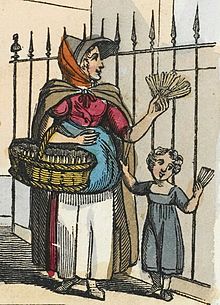 “match” was known in Europe, but it was much more similar to what we think of as a wick or a fuse. It was a chemically treated cord which burned slowly but continuously, and could be used to ignite the touch-hole of a cannon or a campfire.
“match” was known in Europe, but it was much more similar to what we think of as a wick or a fuse. It was a chemically treated cord which burned slowly but continuously, and could be used to ignite the touch-hole of a cannon or a campfire.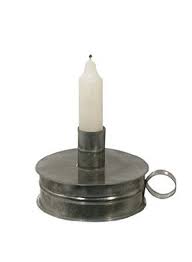 place for a candle so that you could use it as a holder if you wished.
place for a candle so that you could use it as a holder if you wished.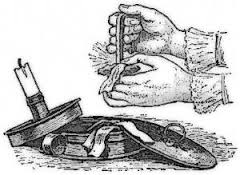 encouraged by a few soft, steady breaths. Once the tinder was burning steadily, a match was applied to it. The match would ignite and be applied to a candle for light, or to a taper or paper spill to be used to light a fire laid on the hearth. As soon as the match had been ignited, the damper was put back into the tinderbox to snuff out the tinder so that it could be used again.
encouraged by a few soft, steady breaths. Once the tinder was burning steadily, a match was applied to it. The match would ignite and be applied to a candle for light, or to a taper or paper spill to be used to light a fire laid on the hearth. As soon as the match had been ignited, the damper was put back into the tinderbox to snuff out the tinder so that it could be used again.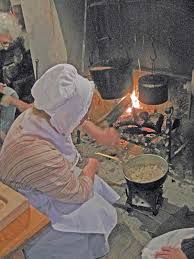 smoldering embers and then add fuel to renew the fire. As it was not always convenient to dash to the kitchen hearth for a light, many homes kept a tinderbox on each mantelpiece. A thoroughly utilitarian domestic appliance, a tinderbox might be kept out of sight in an elegant town home or an opulent country mansion, except for those made of brass or silver. Still, it was a common feature of modest houses and cottages.
smoldering embers and then add fuel to renew the fire. As it was not always convenient to dash to the kitchen hearth for a light, many homes kept a tinderbox on each mantelpiece. A thoroughly utilitarian domestic appliance, a tinderbox might be kept out of sight in an elegant town home or an opulent country mansion, except for those made of brass or silver. Still, it was a common feature of modest houses and cottages.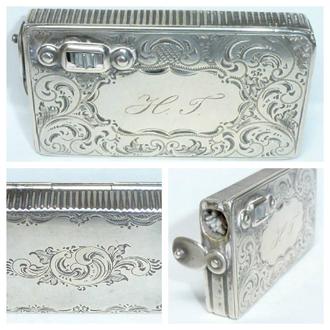
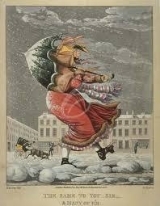 Being born and raised in the southern United States, I have never been a fan of cold weather. While I don’t care for really hot weather either, if I had to choose between sweating to death or being turned into a popsicle, I would definitely choose the former.
Being born and raised in the southern United States, I have never been a fan of cold weather. While I don’t care for really hot weather either, if I had to choose between sweating to death or being turned into a popsicle, I would definitely choose the former.
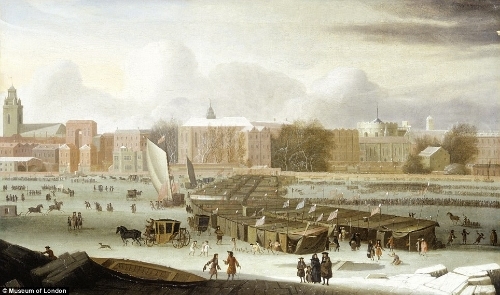 Moreover, it was said that there were up to ten printing presses in operation making cards and popular sheet-music of the time. A printer named George Davis published a 124-page book, Frostiana: or a History of the River Thames in a Frozen State, and the entire book was type-set and printed in Davis’s stall. Unlicensed gambling, drinking and dancing were likely the greatest draws at the fairs, there were stalls selling food, drink, souvenirs and personalized keepsakes for just a few pennies. Featured in the Museum of London’s
Moreover, it was said that there were up to ten printing presses in operation making cards and popular sheet-music of the time. A printer named George Davis published a 124-page book, Frostiana: or a History of the River Thames in a Frozen State, and the entire book was type-set and printed in Davis’s stall. Unlicensed gambling, drinking and dancing were likely the greatest draws at the fairs, there were stalls selling food, drink, souvenirs and personalized keepsakes for just a few pennies. Featured in the Museum of London’s 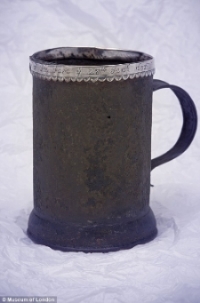 set of memorabilia are a souvenir tankard from the frost fair of 1683 and a souvenir silver spoon from the frost fair of 1683 to 1684.
set of memorabilia are a souvenir tankard from the frost fair of 1683 and a souvenir silver spoon from the frost fair of 1683 to 1684.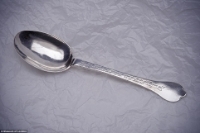 the 29 of January 1683/4.’
the 29 of January 1683/4.’


